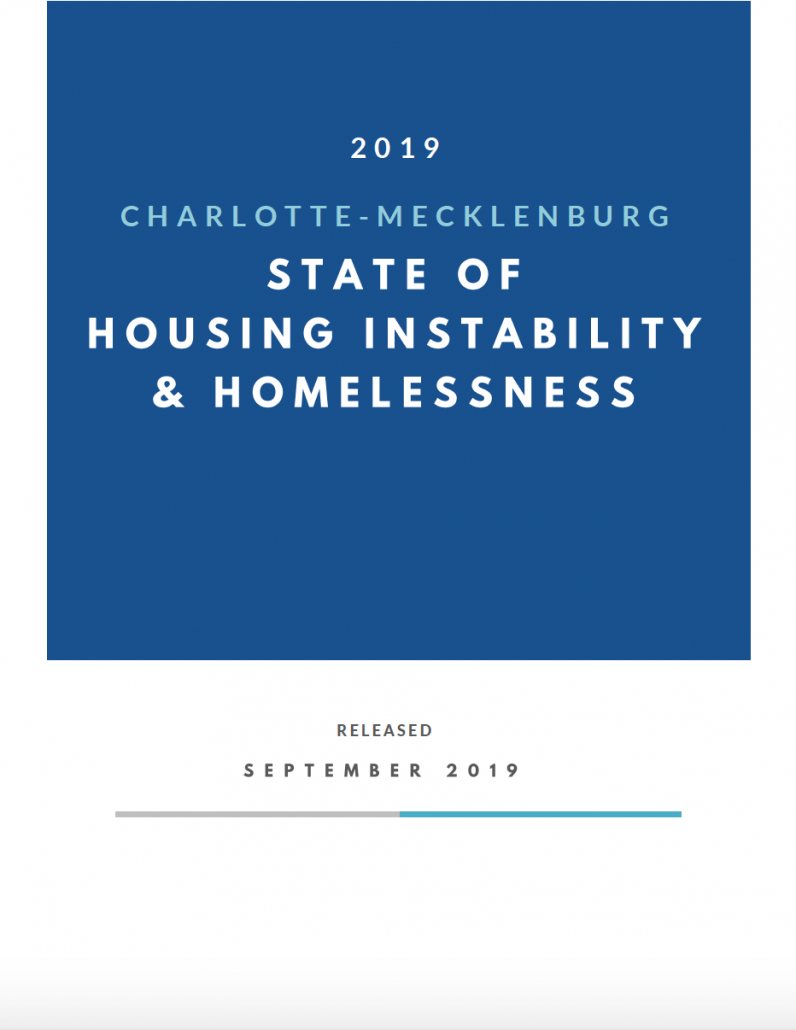Courtney Morton
Mecklenburg County Community Support Services
Bridget Anderson
UNC Charlotte Urban Institute
Mecklenburg County Community Support Services released today (September 26) the annual Housing Instability & Homelessness Report. The Housing Instability and Homelessness Report is the only community housing report that combines all data on housing and homelessness across the continuum.
This report is part of the Housing Instability & Homelessness Report Series, which is produced by UNC Charlotte Urban Institute and funded by Mecklenburg County Community Support Services.
This blog post describes key findings from the report and what it means for Charlotte-Mecklenburg.
THE FULL HOUSING CONTINUUM
Housing Instability, homelessness and stable housing each comprise their own ecosystem within the housing continuum and, when considered together, can be viewed as a part of a larger ecosystem that is impacted by other systems and structures including childcare, transportation, and healthcare. The challenges that lead to increased homelessness and housing instability are linked, which means that effective solutions must address the processes and relationships across the continuum.
Key findings for each of these sections are provided on pages 12-14.
KEY FINDINGS
Housing instability and homelessness indicators reflect an overall increase in the need for both access to and inventory of affordable housing. While Charlotte-Mecklenburg continues to make some progress in the work to end and prevent homelessness and increase affordable housing, it is not enough, especially for households of color and for those at the lowest income.
- More than half of African American and Latinx renter households are cost-burdened, spending more than 30% of their income on housing related expenses. This sustained trend reflects a pattern of systems and structures that have historically and continue to perpetuate disproportionate access to wealth and resources.
- There were 2,106 individuals experiencing homelessness in the community between FY18 and FY19. There was an average of 617 calls per month to NC 2-1-1 requesting housing assistance, indicating a continued need for housing that is affordable.
- The largest gap in affordable housing continues to be for households earning below 30% of Area Median Income (AMI). In 2017, this gap was a 27,022 unit gap between the number of households at or below 30% AMI in Mecklenburg County and the number of units affordable and available to those households. In addition, more than 1,600 units in subsidized developments are at risk of losing their subsidies in the next 10 years. This gap impacts the homelessness ecosystem, which saw an average increase of 28 days in emergency shelter.
SO, WHAT
Each year, the Housing Instability & Homelessness Report expands with new data. The 2019 Report has three important new data findings:
- The 2019 report expands upon last year’s analysis on the rental mismatch to include all of Mecklenburg County. The rental mismatch analysis helps visualize the gap in between the number of households at or below 30% AMI in Mecklenburg County and the number of units affordable and available to those households. Understanding where the largest gaps exist is critical to target community resources and effectively address the shortage of housing.
- The 2019 report debuts the “One Number,” which more accurately reflects how many people are currently experiencing homeless in Charlotte-Mecklenburg. Whereas the Point-in-Time Count number provides a one-night snapshot in January, the One Number, which is generated from HMIS, provides a comprehensive and real-time snapshot of individuals actively experiencing sheltered and unsheltered homelessness. The One Number will continue to be updated regularly via the Dashboard.
- The 2019 report features data from the National Housing Preservation Database, which was developed to help preserve affordable, federally-funded, public housing stock. The report outlines how many affordable rental units with federal subsidies will expire in the next 5 to 20 years. In order to effectively address the affordable housing shortage in Charlotte-Mecklenburg, it is important to know how many units are at risk of being losing their affordability in addition to knowing the shortage, or gap that currently exists.
It is important to understand the problems unique to each component of the housing continuum as well as the connections across the system. Ending and preventing homelessness and reducing housing instability requires a comprehensive, collaborative and coordinated community approach.
To learn more about how to use the information from the report, download the Toolkit here.
Courtney Morton coordinates posts on the Building Bridges Blog. Courtney is the Housing & Homelessness Research Coordinator for Mecklenburg County Community Support Services. Courtney’s job is to connect data on housing instability, homelessness and affordable housing with stakeholders in the community so that they can use it to drive policy-making, funding allocation and programmatic change.
Bridget Anderson is a Social Research Specialist at the UNC Charlotte Urban Institute. She works to provide data insights for community issues relating to homelessness, public health, and social capital.


